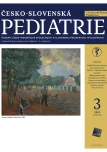Hepatocellular carcinoma in an infant with tyrosinemia type 1
Authors:
Kelifová Silvie 1; Honzík Tomáš 1; Tesařová Markéta 1; Gonsorčíková Lucie 2; Sticová Eva 3; Mašková Jana 4; Mališ Josef 5; Froněk Jiří 6; Zeman Jiří 1
Authors‘ workplace:
Klinika pediatrie a dědičných poruch metabolismu 1. lékařské fakulty Univerzity Karlovy a Všeobecné fakultní nemocnice v Praze
1; Pediatrická klinika 1. lékařské fakulty Univerzity Karlovy a Fakultní Thomayerovy nemocnice
2; Pracoviště klinické a transplantační patologie, Institut klinické a experimentální medicíny
3; Pracoviště radiodiagnostiky a intervenční radiologie, Institut klinické a experimentální medicíny
4; Klinika dětské hematologie a onkologie 2. lékařské fakulty Univerzity Karlovy a Fakultní nemocnice Motol
5; Klinika transplantační chirurgie, Institut klinické a experimentální medicíny
6
Published in:
Čes-slov Pediat 2023; 78 (3): 161-165.
Category:
Case Report
doi:
https://doi.org/10.55095/CSPediatrie2023/021
Overview
Tyrosinemia type 1 is a rare metabolic disease with autosomal recessive inheritance caused by biallelic mutations in the FAH gene, leading to impaired activity of fumarylacetoacetate hydrolase, a key enzyme in tyrosine metabolism. In children with TYR 1, an activation of alternative metabolic pathway leads to an overproduction of toxic metabolites, mainly succinylacetone and fumarylacetoacetate, which damage hepatocytes and renal tubular cells. Clinically, TYR 1 presents with acute progression to liver and renal failure at an early age or chronically with the development of liver fibrosis, cirrhosis, rickets and hepatocellular carcinoma, manifestations of porhyria crisis are also common. Biochemical diagnosis is based on evidence of increased levels of succinylacetone in the blood and urine, accompanied by an elevation of tyrosine and rising level of alpha-fetoprotein. The diagnosis must be confirmed at the molecular level. The treatment is based on an administration of nitisinone, which blocks the production of toxic metabolites in combination with a low-protein diet supplemented with a mixture of essential amino acids without tyrosine and phenylalanine. If conservative therapy does not prevent the progression of liver failure or the development of hepatocellular carcinoma, liver transplantation is indicated. We present the clinical course of the disease in a 10-month-old boy with TYR1, manifesting with hepatopathy, melena, and hepatocellular carcinoma. In addition to nitisinone and diet, chemoembolization of the supplying hepatic artery in the area of the fastest-growing carcinoma was necessary, which enabled us to gain time to prepare liver transplantation. After a successful transplant, the boy is in a good clinical condition.
Keywords:
liver transplantation – succinylacetone – hepatocellular carcinoma – tyrosinemia type 1 – nitisinone – transarterial chemoembolization (TACE )
Sources
1. Honzík T, Zeman J. Dědičné poruchy metabolismu aminokyselin, organických kyselin a cyklu močoviny. Ces-slov Pediat 2022; 77(6): 120–120.
2. Mayorandan S, Meyer U, Gokcay G, et al. Cross-sectional study of 168 patients with hepatorenal tyrosinaemia and implications for clinical practice. Orphanet J Rare Dis 2014; 9: 107.
3. Hutchesson AC, Hall SK, Preece MA, et al. Screening for tyrosinaemia type I. Arch Dis Child Fetal Neonatal Ed 1996; 74(3): F191–4.
4. Lindstedt S, Holme E, Lock EA, et al. Treatment of hereditary tyrosinaemia type I by inhibition of 4-hydroxyphenylpyruvate dioxygenase. Lancet 1992; 340(8823): 813–817.
5. Weinberg AG, Mize CE, Worthen HG. The occurrence of hepatoma in the chronic form of hereditary tyrosinemia. J Pediatr 1976; 88(3): 434–438.
6. van Spronsen FJ, Thomasse Y, Smit GP, et al. Hereditary tyrosinemia type I: a new clinical classification with difference in prognosis on dietary treatment. Hepatology 1994; 20(5): 1187–1191.
7. Québec NTBC Study Group; Alvarez F, Atkinson S, et al. The Québec NTBC Study. Adv Exp Med Biol 2017; 959: 187–195.
8. de Laet C, Dionisi-Vici C, Leonard JV, et al. Recommendations for the management of tyrosinaemia type 1. Orphanet J Rare Dis 2013; 8: 8.
9. Digiacomo G, Serra RP, Turrini E, et al. State of the art and perspectives in pediatric hepatocellular carcinoma. Biochem Pharmacol 2023; 207: 115373.
10. Varol Fİ. Pediatric hepatocellular carcinoma. J Gastrointest Cancer 2020; 51(4): 1169–1175.
11. Ranganathan S, Lopez-Terrada D, Alaggio R. Hepatoblastoma and pediatric hepatocellular carcinoma: an update. Pediatr Dev Pathol 2020; 23(2): 79–95.
Labels
Neonatology Paediatrics General practitioner for children and adolescentsArticle was published in
Czech-Slovak Pediatrics

2023 Issue 3
Most read in this issue
- Inherited disorders of carbohydrate metabolism
- Sclerosing cholangitis in children with inflammatory bowel disease
- Late diagnosis of mucopolysaccharidosis type I in a girl with hand contractures
- Hepatocellular carcinoma in an infant with tyrosinemia type 1
